Photographed by Noelle Gaberman
trans·hu·mance
noun
the action or practice of moving livestock from one grazing ground to another in a seasonal cycle, typically to lowlands in winter and highlands in summer.
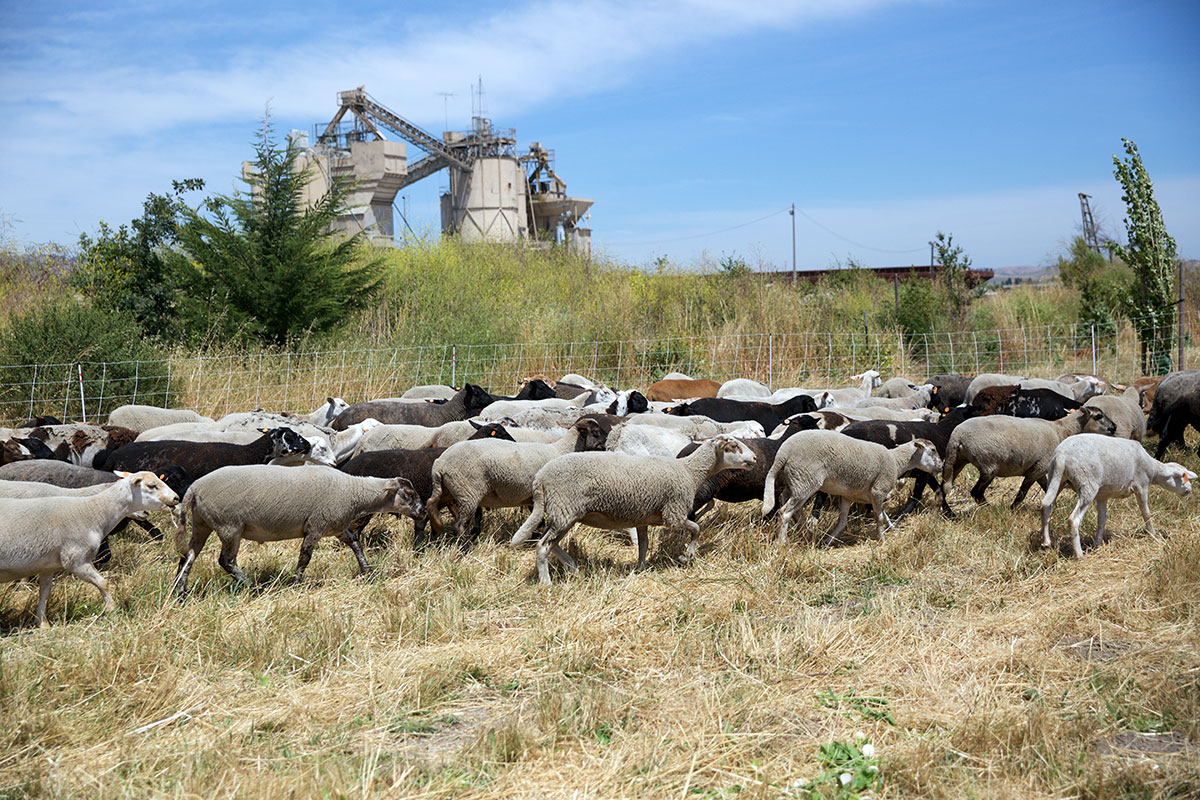
Grassland, prairie, savanna—in some regions these landscapes are so ubiquitous that they are paradoxically invisible. They are everywhere, and so we don’t see them. Easily overlooked and even easier to develop into intensive agriculture or housing, grassland is often referred to as “marginal land.”
Yet in California, there could not be a more relevant time to draw attention to the health of the open expanses of land surrounding our towns and cities. Last October, wicked winds spawned a fire complex that burned 250,000 acres in Northern California, destroying 9,000 structures and claiming 44 lives. Flames shot into the middle of Santa Rosa from the nearby Mayacamas coast range, and destroyed entire neighborhoods in its path.
It was one of the deadliest and most destructive fire complexes in California’s modern history, and at the time of this writing, a new series of fires has already claimed lives and even more land than the year before across the state.
The 2017 fires were reportedly caused by a perfect storm of unusual weather patterns (dubbed “Diablo winds”), compromised PG&E equipment, and untended vegetation.
It’s this latter factor why folks like Aaron Gilliam of Sweetgrass Grazing have a growing list of clients in the North Bay. Along with willing sheep and goats, a reliable band of shepherds, and a couple of border collies, Gilliam’s contract grazing outfit is grazing 350 acres this year across 12 land bases, and is ready to expand as soon as he finds a bigger home base for his hard-working herd.
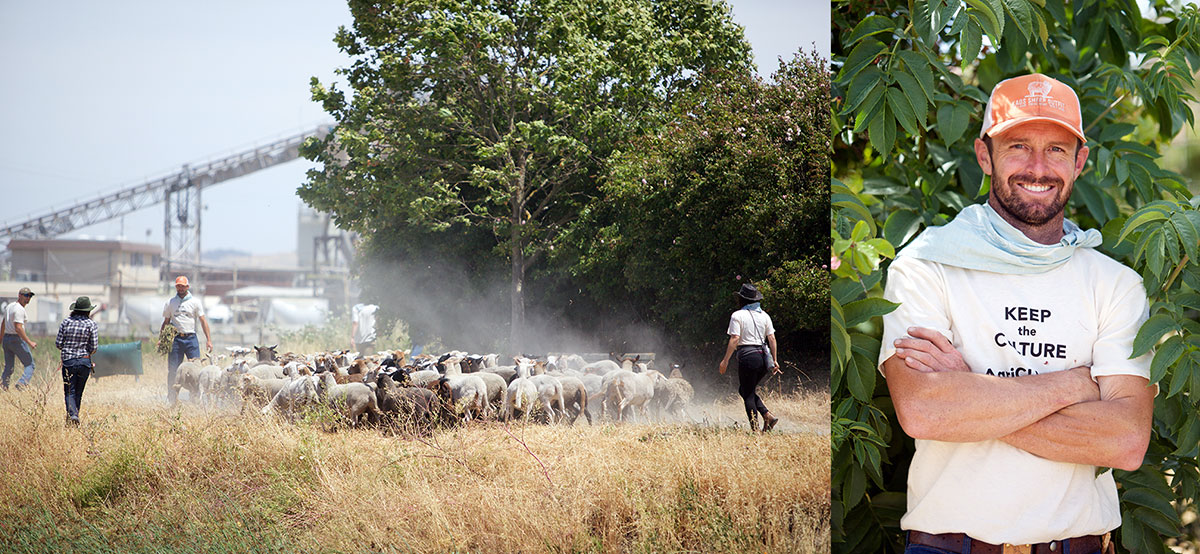
Unlike mowers and herbicides, grazing animals not only remove vegetation (through eating and trampling), but also yield that biomass back to the environment in the form of trampled litter and manure. There, it can decay biologically, build soil, and promote the storage of carbon deep in the soil. And unlike equipment, grazing animals have rumens that allow them to digest what human and machine cannot.
What’s more, the Sweetgrass flocks and their athletic shepherds and sheepdogs can climb heights and hills inaccessible to heavy equipment, rivaling the reach of fire itself. And with good management, the animals can halt or slow the spread of highly flammable scrub by creating the conditions for more desirable and diverse species to germinate and thrive.
They don’t just graze out (remove) unwanted species—by changing the landscape from the soil up, they graze in (increase) healthier grassland compositions.
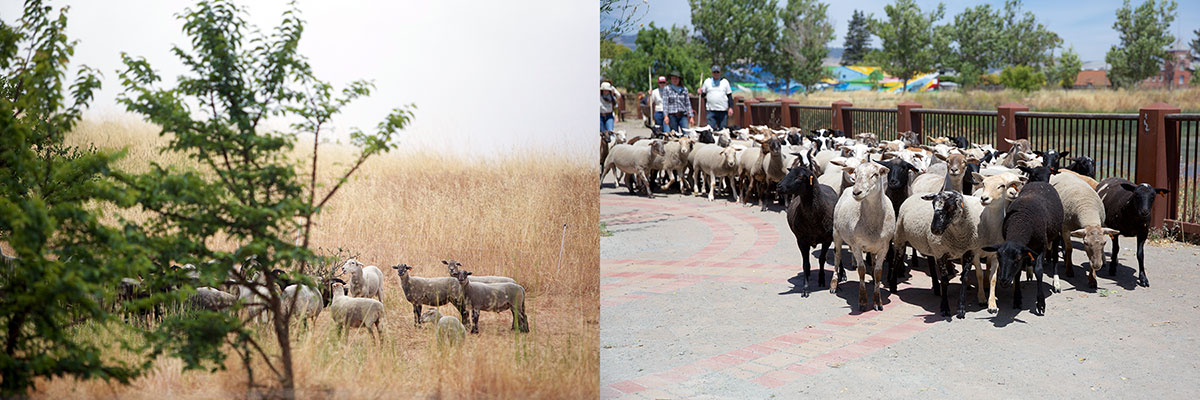
As a result of this kind of grazing, characterized by a relatively large number of animals grazing for short periods of time, land is rendered not fireproof, but rather fire resilient. It’s less likely to burn, and flames that do cross those lands are less intense and more easily controlled, often leaving healthier land in their wake. This style of management mimics the effects of the large herds of bison, mammoth, antelope, and elk that dominated our California prairie landscapes until recent history.
Such sensitive land stewardship takes a degree of logistical planning akin to the consonance of a symphony. Moving livestock across countryside in a way that improves the land without compromising the animals takes constant planning and daily shepherding. Indeed, Aaron works with a small group of local agrarians contracted to spend all day with the sheep, sometimes sleeping out with them to guard against predators and ensure the animals are moving to their next paddock at just the right time.
However, Sweetgrass often grazes disconnected landscapes, and their greatest single expense to Sweetgrass’ business is transportation. It can cost hundreds of dollars to move animals, and thousands of dollars to hire a semi truck to move large groups of animals even a short distance. And with so much historical grassland in in Sonoma County subdivided into small and separate parcels, those fees add up.
The most elegant way to nimbly move from acreage to acreage, and least stressful on the animals, is simply to herd them down the road.
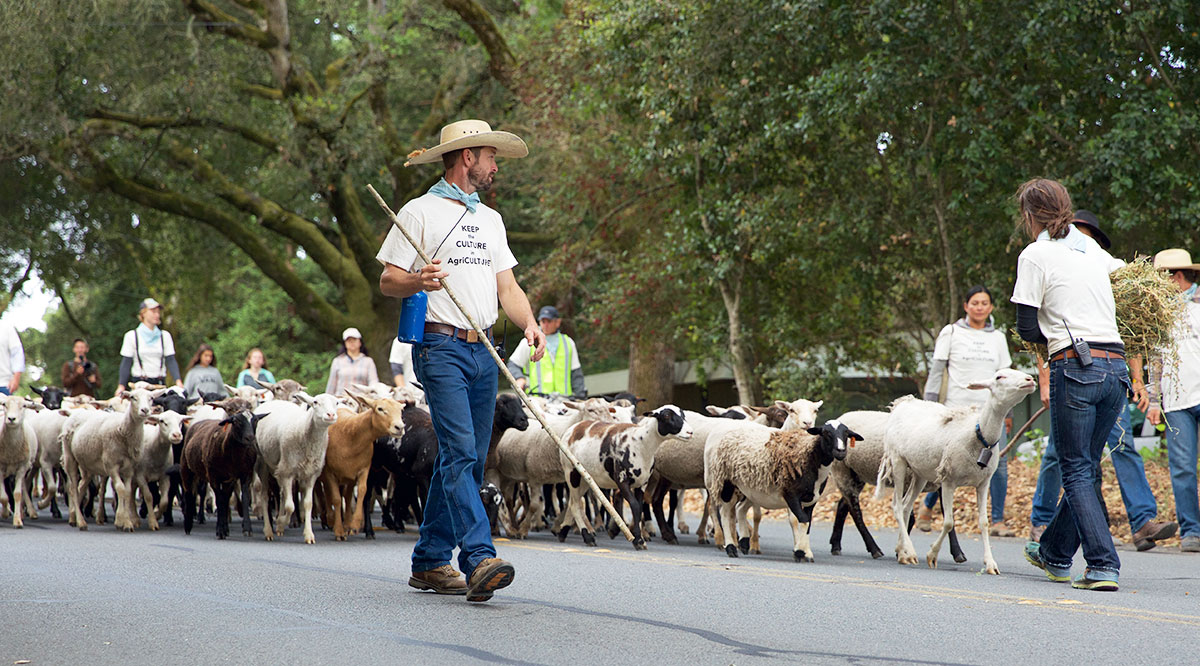
It was this problem that got Guido Frosini thinking. Guido, a young Italian rancher who owns True Grass Farms in Tomales, is a collaborator of Aaron’s. Last Spring, Guido and Fibershed contributor Brittany Cole Bush explored all around the Basque region, Southern France, and Spain, learning the nuts and bolts of its grazing schools and pastoral culture in the hopes of cultivating similar training and reviving traditions in the United States.
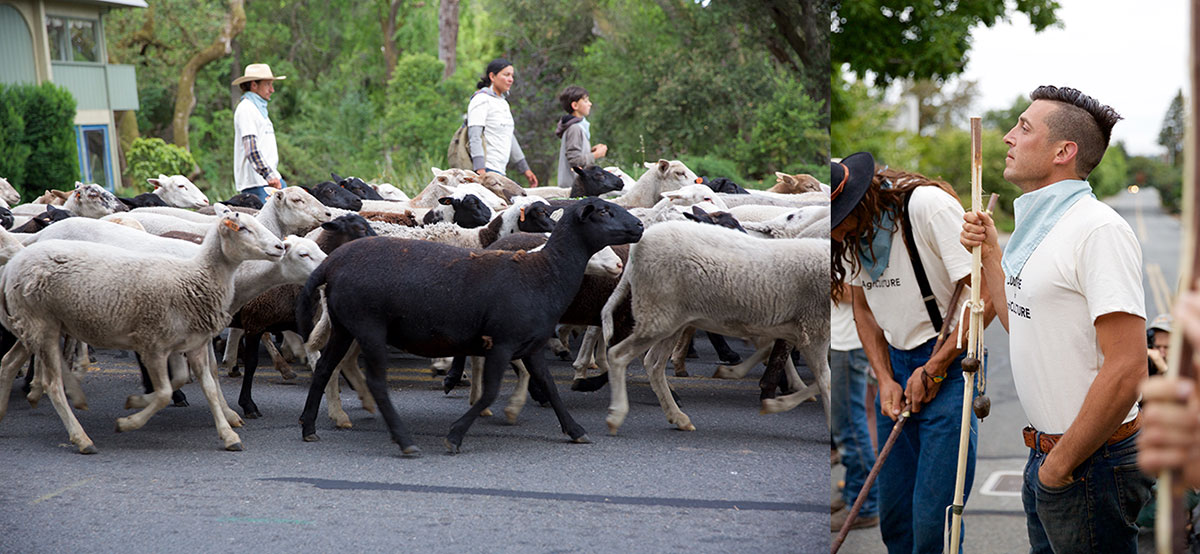
Guido grew up in Italy, but it wasn’t until this trip that he experienced his first transhumance festival: the celebratory and highly-visible migration of livestock from the surrounding hills right through the city center. Part practical, part spectacle, this movement through town allows for not only the buying and selling of animals, but also a festive time to sustain a pastoral culture that remains central to so many around the globe.
Guido marveled at this, and wondered if the need to move animals on public roadways could be an opportunity to raise public support for healthy grassland, resilient landscapes, and the people who tend them. Couldn’t we—shouldn’t we—be doing this at home in Northern California? He set to work pitching the idea to friends, chefs, shepherds and the Petaluma police.
Fast forward to 6:30 AM on a June Saturday in Petaluma. The herders were thirty strong, sporting long walking sticks and natural indigo-dyed bandanas highlighting the themes of sheep, shepherds, sun and moon, waves, and the passing on of harmonious grassland tradition from generation to generation. Designed especially for the event by Fibershed member Kori Hargreaves, the bandanas, as well as organic cotton shirts from Harvest and Mill, helped to mark and distinguish the herders. Among them were shepherds, ranchers, artists, poets, shearers, farmers, grassland ecologists, photographers, and general grazing groupies. By 7 AM, the small flock of sheep were ready to go.
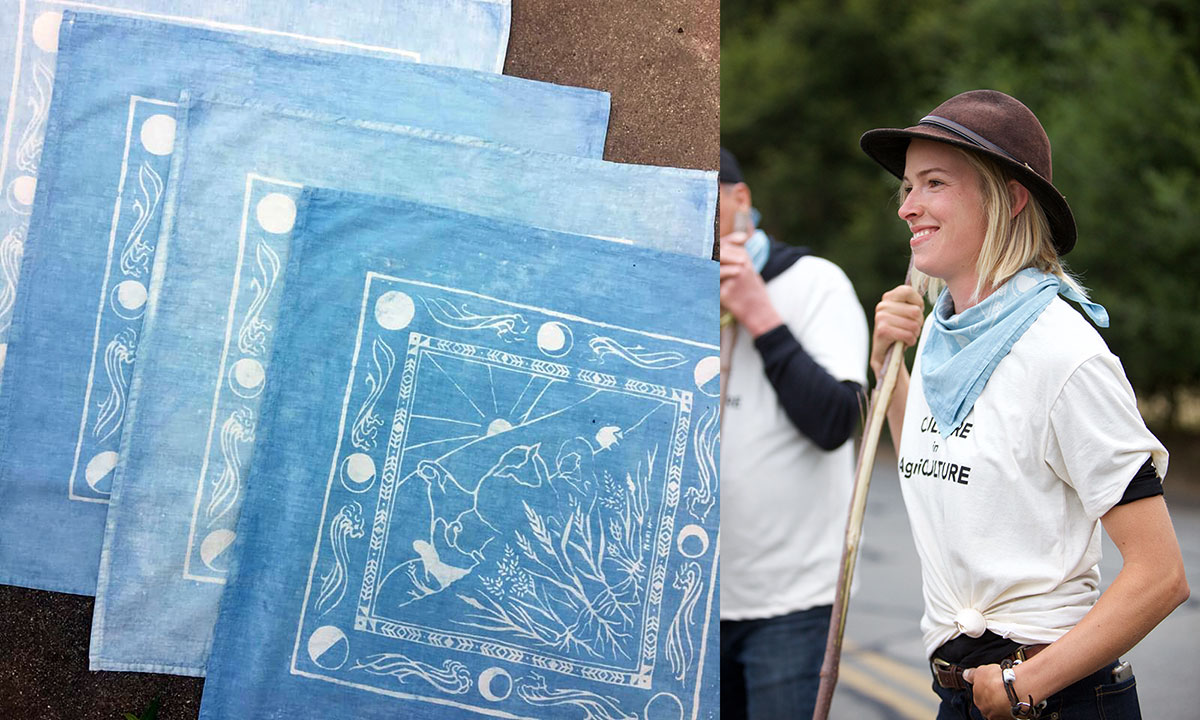
Left: picture by Kori Hargreaves; Right: the author wearing her bandana
The destination: Steamer Landing Park in downtown Petaluma, home to the Friends of the Petaluma River’s River Heritage Center – and Sweetgrass’ next contract. Having collaborated on fundraising events in the past, Guido was keen to partner again, supporting their work around watershed awareness and expanding on their network’s interest to include grasslands, an often-overlooked component of healthy watersheds. With a lot of support from local collaborators, he schemed up June 9th’s first annual Transhumance Festival in Petaluma, “a celebration of grassland culture, resiliency, and dedication to good food.”
“Come, sheep!” Aaron yelled, as he and some shepherds opened the electronet fencing. With that, four hundred hooves skittered down a grassy slope of a grazing contract south of town. They hit the pavement, bells jingling, and the party was off. The flock, herders, and Petaluma police escort were soon joined by curious neighbors, children, dog-walkers, and morning cyclists. As they wound their way down the 2.2 mile walk to their destination at Steamer Landing Park, the procession swelled and soon the small flock of 100 sheep were surrounded by a large crowd of excited neighbors keeping pace.
By 8 AM, the sheep and their shepherds rolled in to a paddock just outside the park, having successfully navigated through busy neighborhoods and an urban downtown.
After a whirlwind of setup, the festival kicked off at 2 PM, by walking the flock of sheep, led by a local bagpiper and followed by festival-goers, through the park gates into their final paddock on the peninsula.
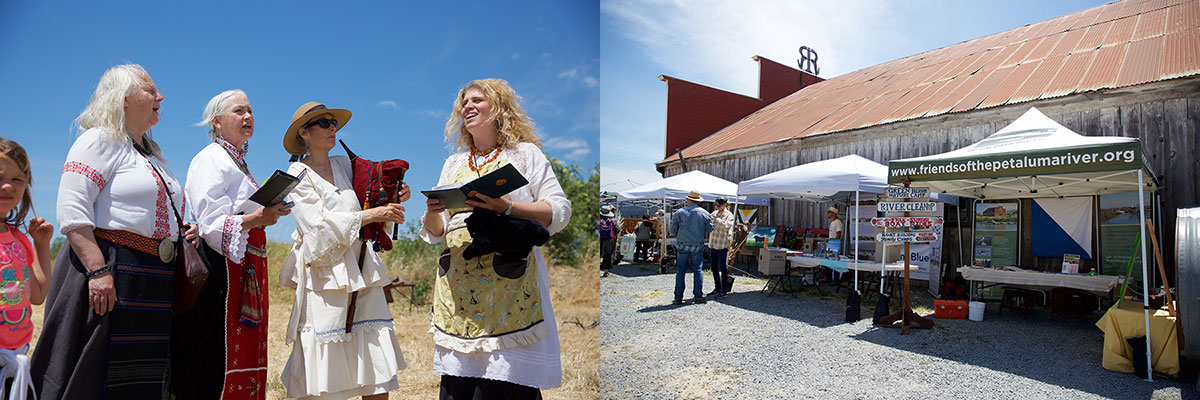
Guests began pouring in, finding themselves in a pop-up village where old meets new. Balkan bagpipe performers in traditional clothing sang old folk songs as a marketplace of Fibershed producers offered a foray fiber and dye from the local bioregion available for purchase. Snacks of local cheese and bull meat salumi satiated guests while chefs were hard at work preparing a hearty supper from home-grown ingredients.
Near the historic barn, three lambs cooked asado style by a tended fire, while local educators and organizations shared with visitors all about the relationship between fire, birds, grazing, healthy land, and everything in between.
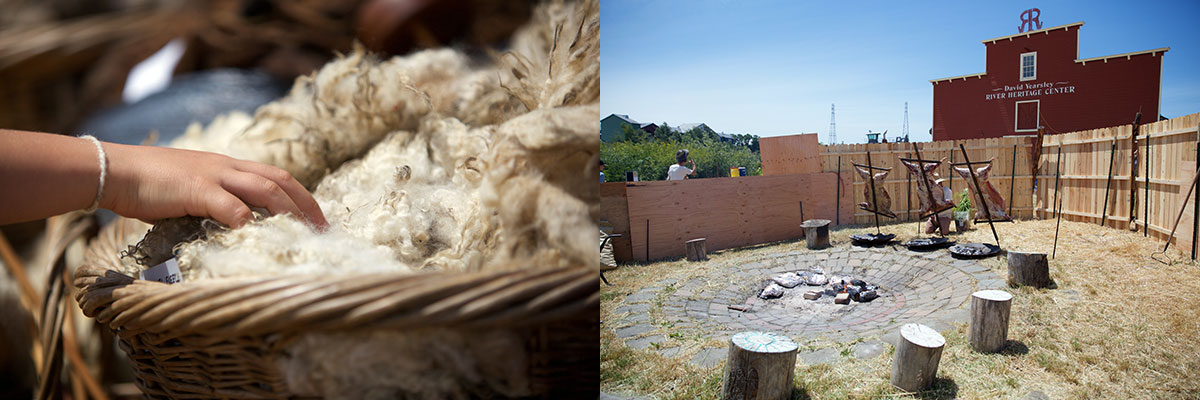
By mid-afternoon, the Petaluma winds kicked up, sending tents toppling. But the attendees rallied and the show went on, beginning with a demonstration by farmer and local sheep shearer Lora Kinkade. In her moccasins, strong arms, and suspenders, she looked part tradesperson part action hero, and elegantly demonstrated to the circled-up crowed how humanely sheep shearing could be done while the wind carried bits of fleece into the surrounding waters.
By four o’clock, it was time for the series of talks. John Wick, of the Marin Carbon Project wove the threads of compost, carbon, grasslands, and good management. Food activist and writer Stephen Satterfield of Whetstone Magazine spoke on “food, sovereignty, and food sovereignty,” giving the mostly-white crowd some grist for the mill as they considered how food and social justice intersect.
Closing the afternoon of deep education was an original play by Ruthie King of the School of Adaptive Agriculture entitled A History of Domestication. Featuring fifteen different actors dressed in wolf masks, skulls, and sheep hides, the play covered about 100,000 years within the span of 20 minutes, charting humans’ incremental shift from wandering scavengers to pastoralists to sedentary farmers, ending with a riotous dance final scene that set the stage for the evening of revelry to come.
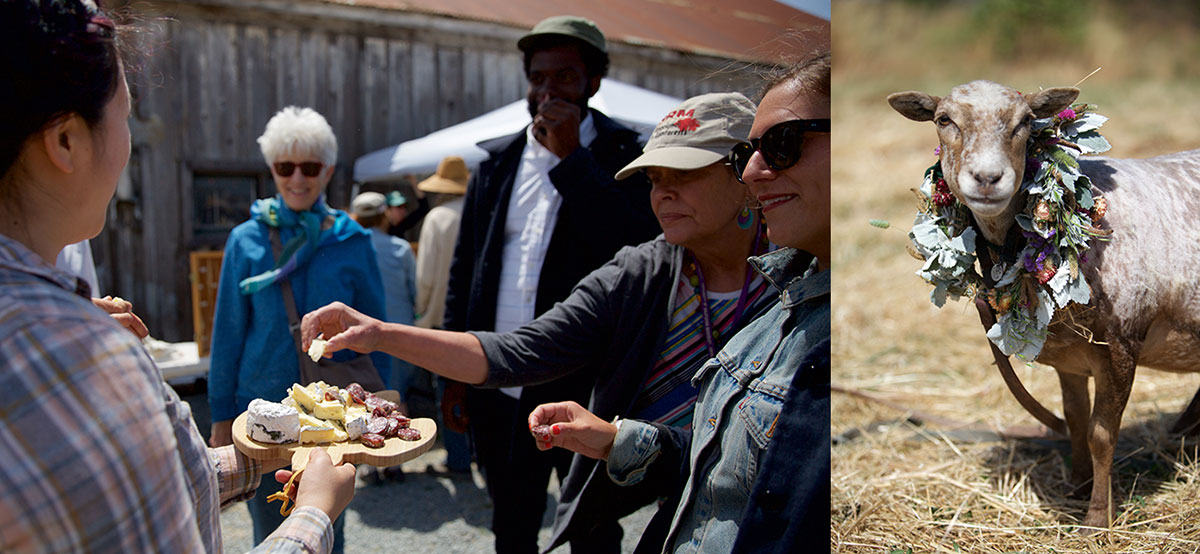
As public awareness of the vital role of animals in ecological health grows, and makes way for the diligent and inspired work of restorative ranchers and shepherds, a grassland culture revives. Dynamic but cyclical, transient but self-renewing, always skillful and perennially playful… whatever grassland culture is or is yet to come, it will certainly involve food and dance.
The first annual Transhumance Festival was a spectacle, but with a deeply substantial cause: to remind the public of the land beyond, and the people and practices that keep it resilient and productive. Stay tuned, because plans are already underway to continue the tradition in 2019.
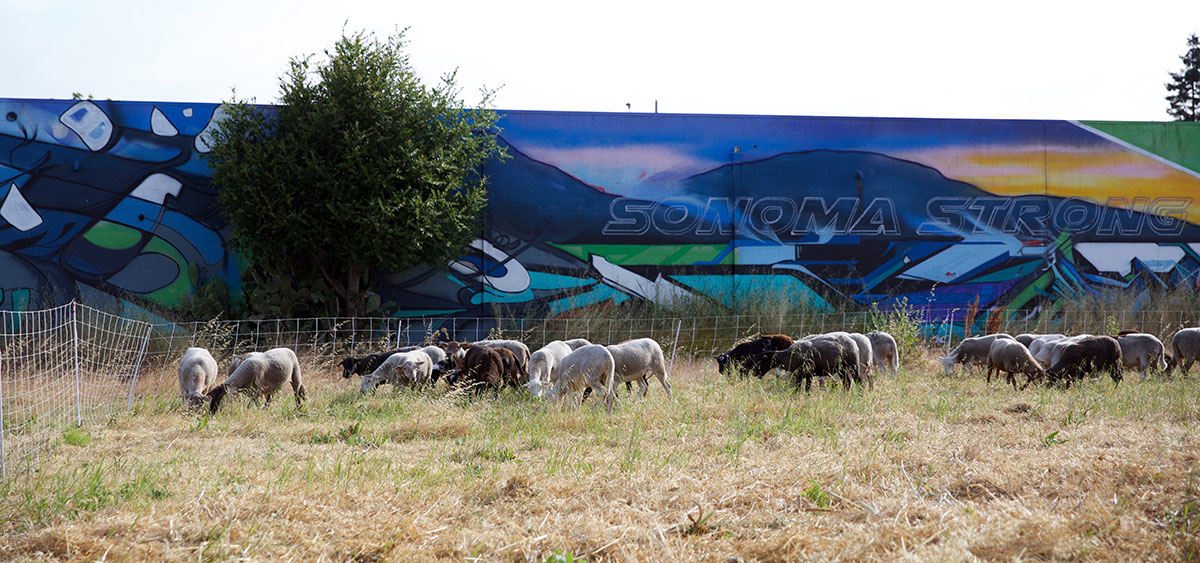
For more information on Transhumance Festival in Petaluma, visit their website www.sassyandgrassy.com or find them on Instagram @transhumancefestival. To order a bandana of your own, visit the Full Circle Wool Etsy shop. Save the date for the next Transhumance Festival in Petaluma on May 11, 2019!














